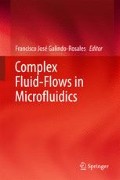Abstract
Numerical modelling can illuminate the working mechanism and limitations of microfluidic devices. Such insights are useful in their own right, but one can take advantage of numerical modelling in a systematic way using numerical optimization. In this chapter we will discuss when and how numerical optimization is best used.
Access this chapter
Tax calculation will be finalised at checkout
Purchases are for personal use only
Notes
- 1.
Animations available at https://en.wikipedia.org/wiki/Nelder%E2%80%93Mead_method. Cited 30 April 2017.
- 2.
A value three orders of magnitude larger than the machine precision is a good starting point, but the optimal value is problem dependent and it is thus a good idea to study, when numerical noise dies out and 2nd order effects sets in.
- 3.
https://github.com/xuy/pyipopt. Cited 30 April 2017.
References
Alnæs, M., Blechta, J., Hake, J., Johansson, A., Kehlet, B., Logg, A., et al. (2015). The FEniCS project version 1.5. Archive of Numerical Software, 3(100): 9–23.
Alves, M.A. (2011). Design of optimized microfluidic devices for viscoelastic fluid flow. In Technical Proceedings of the 2011 NSTI Nanotechnology Conference and Expo. 2: 474–477.
Bongartz, I., Conn, A. R., Gould, N., & Toint, Ph L. (1995). CUTE: Constrained and unconstrained testing environment. ACM Transactions on Mathematical Software (TOMS), 21(1), 123–160.
Campo-Deaño, L., Galindo-Rosales, F. J., Pinho, F. T., Alves, M. A., & Oliveira, M. S. N. (2011). Flow of low viscosity Boger fluids through a microfluidic hyperbolic contraction. Journal of Non-Newtonian Fluid Mechanics, 166(21), 1286–1296.
Evgrafov, A. (2015). On Chebyshev’s method for topology optimization of Stokes flows. Structural and Multidisciplinary Optimization, 51(4), 801–811.
Farrell, P. E., Ham, D. A., Funke, S. W., & Rognes, M. E. (2013). Automated derivation of the adjoint of high-level transient finite element programs. SIAM Journal on Scientific Computing, 35(4), C369–C393.
Galindo-Rosales, F. J., Oliveira, M. S. N., & Alves, M. A. (2014). Optimized cross-slot microdevices for homogeneous extension. RSC Advances, 4(15), 7799–7804.
Jensen, K. E., Szabo, P., Okkels, F., & Alves, M. A. (2012). Experimental characterisation of a novel viscoelastic rectifier design. Biomicrofluidics, 6(4), 044112.
Jensen, K. E., Szabo, P., & Okkels, F. (2012). Topology optimization of viscoelastic rectifiers. Applied Physics Letters, 100(23), 234102.
Jensen, K. E., Szabo, P., & Okkels, F. (2014). Optimization of bistable viscoelastic systems. Structural and Multidisciplinary Optimization, 49(5), 733–742.
Krühne, U., Larsson, H., Heintz, S., Ringborg, R. H., Rosinha, I. P., Bodla, V. K., et al. (2014). Systematic development of miniaturized (bio) processes using Process Systems Engineering (PSE) methods and tools. Chemical and Biochemical Engineering Quarterly, 28(2), 203–214.
Lin, S., Zhao, L., Guest, J. K., Weihs, T. P., & Liu, Z. (2015). Topology optimization of fixed-geometry fluid diodes. Journal of Mechanical Design, 137(8), 081402.
Svanberg, K. (1987). The method of moving asymptotes-A new method for structural optimization. International Journal for Numerical Methods in Engineering, 24(2), 359–373.
Acknowledgements
This work is supported by the Villum Foundation (Grant No. 9301) and the Danish Council for Independent Research (DNRF122).
Author information
Authors and Affiliations
Corresponding author
Editor information
Editors and Affiliations
Rights and permissions
Copyright information
© 2018 Springer International Publishing AG
About this chapter
Cite this chapter
Jensen, K.E. (2018). Numerical Optimization in Microfluidics. In: Galindo-Rosales, F. (eds) Complex Fluid-Flows in Microfluidics. Springer, Cham. https://doi.org/10.1007/978-3-319-59593-1_5
Download citation
DOI: https://doi.org/10.1007/978-3-319-59593-1_5
Published:
Publisher Name: Springer, Cham
Print ISBN: 978-3-319-59592-4
Online ISBN: 978-3-319-59593-1
eBook Packages: EngineeringEngineering (R0)

